In an Iowa NICU, a nurse strives to give a dying baby one final 'loving embrace'
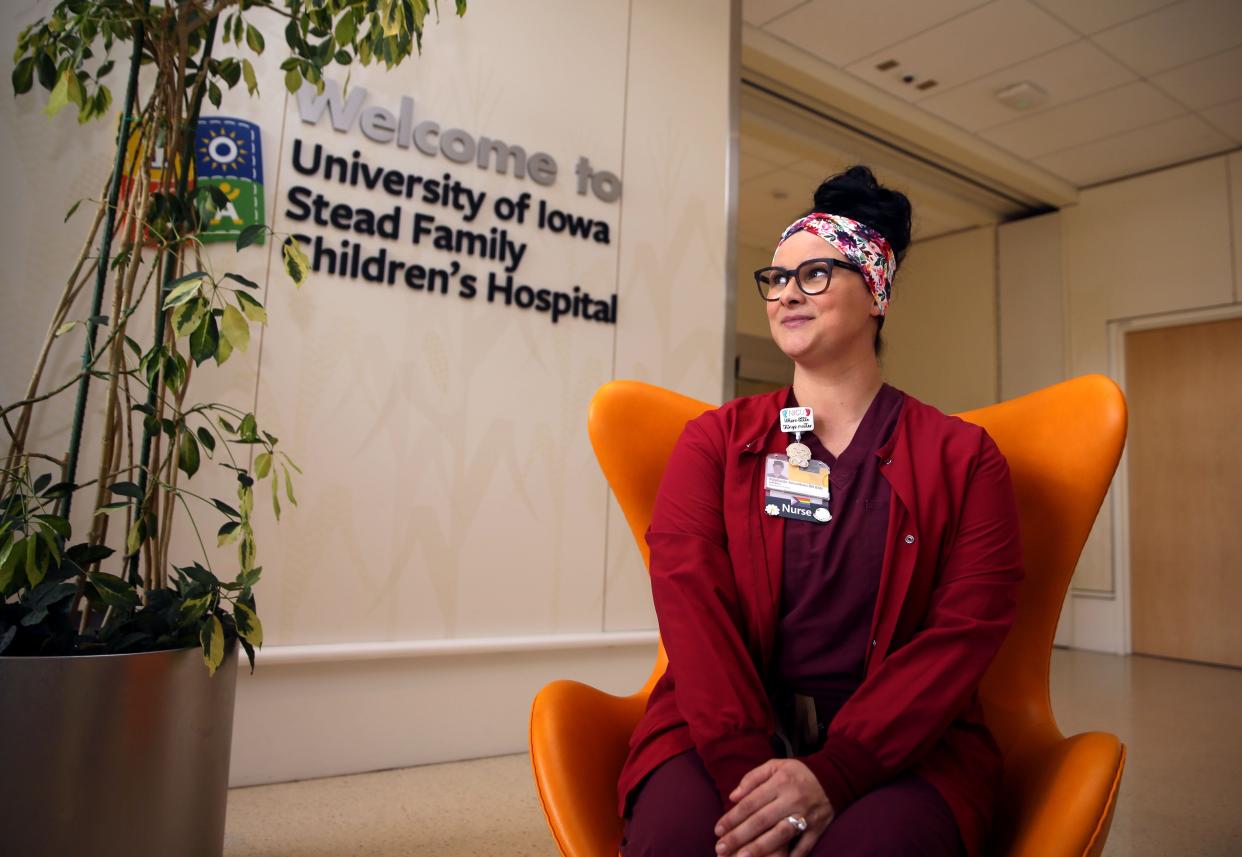
Nurse Stephanie Amundson was having a slow night.
She had one patient, a baby she’d tended to off and on for a couple of weeks. Stable, but, like so many in the University of Iowa’s neonatal intensive care unit, still at the beginnings of what could be a long journey home.
The evening’s charge nurse was down the hallway, standing by for a preemie delivery. It’s fairly standard for the NICU to be on alert when a mom comes in with high-risk factors: diabetes, autoimmune diseases, high blood pressure, previously diagnosed fetal defects or conditions, or, of course, early labor.
All the two nurses knew then was that this baby was post-30 weeks, which is premature, yes, but nowadays has a 96% survivability rate.
With the normally beaming bright blues and greens of the floor’s walls and rooms slightly muted by the moonlight, Amundson settled in for a quiet shift of charting and checking in — though nurse's superstition would never let her admit as much, lest she jinx the calm.
And, as if on cue, her duty phone broke the tranquility.
You need to set up a bed right now, the charge nurse says.
Yep, absolutely, Amundson replies, her paperwork immediately tucked away and her feet already carrying her toward an open room, manifesting the constant flexibility of a caregiver’s life. Nearly two decades as a nurse has taught Amundson to be prepared to confront the unexpected every day — and then come back and do it again the next day and the day after that and the day after that.
What am I setting up for? Amundson asks.
We don’t know exactly what’s going on, the nurse says with a weight that hangs like a quilt between the women, but it’s just not going well.
When the medical team finally comes rushing in with the patient — the baby’s tiny body like a football in the center of a raging typhoon — the situation’s dire nature is only just emerging. The baby’s breathing is impeded, so he’s not getting enough oxygen. His color is terrible. He has physical abnormalities.
His parents, Amundson is told, are new immigrants, and they hadn’t received traditional prenatal care. Not even an ultrasound, she came to understand. They had no idea their baby was anything but healthy.
And no concept of what would happen next.
The care team worked throughout the night, moving the couch out of the room to make way for all the machines that would do what the baby’s body couldn’t. A huge ventilator pushed air in and out of his little chest rhythmically. In… And out… In… And out… In… And out.
Just before dawn heralded shift change, they got the baby as stabilized as possible. Now, the dayside nurses and doctors would start the battery of tests and scans and blood draws to figure out a diagnosis and a care plan.
Amundson was scheduled to work later that night, a Tuesday, but then take a day off Wednesday before returning on Thursday. A pull inside Amundson told her to pick up that extra shift, to be there on Wednesday — even if that meant working four 12-hour-plus shifts in a row.
Continuity of care is especially important with complicated cases, she says. In hospitals, you try to keep what you can consistent, a control in the chaos.
But the tickle in her gut was also nurse’s intuition, a deep-seated emotional understanding that she was the exact right person to handle the crushes headed this baby’s way.
Amundson, then 38, drove the 45 minutes home in silence. Good days were marked by music and karaoke and car dancing, but tough days were still.
She knew she was already invested in “this little guy,” which is what she’d come to call him. This little guy. The little guy.
Her little guy.
And her commitment would make the next few days some of the toughest — and the most rewarding — of her life.
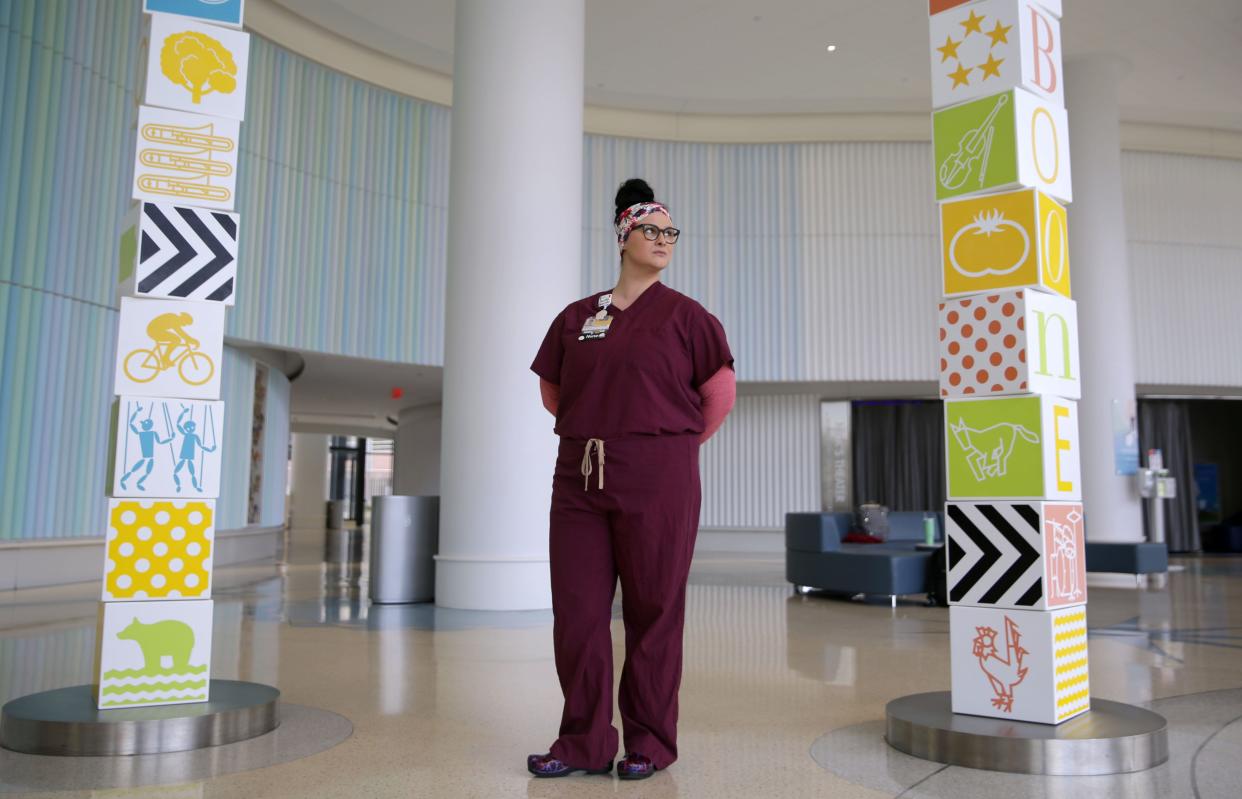
Finding her niche as a nurse: ‘It’s a skill to be with someone in sadness’
The stories of the young lives that begin in the NICU often play out in the patchwork collages taped near their bedsides. Crayola drawings from siblings ready for their new sister or brother to come home. Photos of particularly important nurses or doctors smiling alongside visiting friends and family.
Scrapbook pages of handprints and first moments that parents hope will eventually transfer to a baby book.
Images that detail a family’s journey — and, uniquely, all the joys and trials that hold equal measure when that journey takes place inside a hospital. The power of those posted mementos and the impact she saw nurses having on individual families in each of those posed frames and colorful sketches are what drew Amundson to this work and to the university specifically.
Nurses can’t get too emotionally involved with every single patient; it’s not professional and not a good way to keep your sanity, Amundson says. But with babies, the bond seems stronger, harder to break, a remnant of species protection embedded deep within our DNA.
And maternal instincts come naturally to Amundson. Her soft smile, her light giggle and the gentle way she holds eye contact add up to an immediate feeling of closeness. Of safety, even.
The daughter of two teachers, she was always academically inclined, bookish and organized, “definitely, definitely Type A,” she says with a lilt of self-deprecation.
But little Stephanie just couldn’t stop talking; “real chatty” as she remembers her report cards declaring. “Oh, I was constantly getting in trouble for talking in class or trying to have little side conversations with my friends.”
As much as coursework kept her attention, her fellow students, their lives and their likes and their hopes always seemed just as interesting. Stepping into a new world, she’d come to understand, didn’t just happen through the pages of her favorite books, no. She could see a whole different perspective if she opened her heart and her mind enough to let someone in.
Growing up in Marion, Amundson spent afternoons and free moments in her mother’s preschool classroom, time that nurtured her innate connection to children and keen interest in ways she could foster their growth.
Caring for kids was her future, she knew, but an aptitude for science — biology and anatomy and physiology — sent her down a medical path instead of an educational one. She toyed around with becoming a pediatrician but found her calling in the nursing program at Dubuque’s Clarke University and, eventually, her niche in neonatal care after a round of clinicals in a NICU.
Because the University of Iowa is a world-class teaching hospital — and the state’s only Level 4 NICU — the range of its patients is broad: everything from a 400-gram micro-preemie who’s barely the size of a palm to term babies dealing with infections or waiting for surgeries to 10-month-olds on ventilators or traches.
There are patients whose stay is short and others whose care stretches hundreds of days, even more than a year. And given the wide variety, nurses can have the chance to specialize in, say, cognitive development or pediatric nephrology, as Amundson did.
While doctors necessarily move between patients, Amundson is usually at their bedside for the entirety of her shift. There she plays provider, medical dictionary, cheerleader and confidant all in one. And over the years she’s become a master mood reader.
“Do these people need someone to pray with them? Do these people need someone to be there while they are venting and they are angry? Do you need to absorb that?” she rattles off by way of example. “Do they want to be positive or are they like, 'Just give it to me straight'?”
Healing, she’s learned, doesn’t come from a prescription pad or an IV drip alone. Sometimes the most important medical intervention is when she holds a parent’s hand and reminds them that not going backward is a win. Standing still can be its own kind of pace, too, you know.
“It's a skill to be with someone in sadness,” she says.
Eventually, her nephrology expertise lured Amundson to a clinic nurse job in Wisconsin before a wanderlust attracted her to travel nursing.
A travel contract at her home hospital brought her back to Iowa on what was supposed to be a waylay, a temporary stop to reconnect with family and reset before the next adventure. But this was February 2020, and the COVID pandemic would soon shut down the world — causing many of us to search for a bit of stability in the storm.
And, though she couldn’t know yet, Amundson’s next adventure would be personal.
Bereavement is a painful reality, but it can be beautiful
By the time Amundson returns to the hospital for her shift Tuesday night, the care team had determined the little guy’s lungs hadn’t matured much past the first trimester. Even with his teeny body, his lungs would never be able to pump enough oxygen to sustain him.
With the first night’s frenzied cyclone dulled, the little guy’s ventilator keeps the rhythm of life — In… And out… In… And out… In… And out — while doctors throw everything they can think of at his case. Medical speak can feel like its own dialect even to native English speakers, so Amundson takes extra care to navigate the language barrier and cultural gulf as she translates what’s happening and when and why to the little guy’s parents.
They are a young couple, younger than her, and he is their first. They look numb. Glassy-eyed. Like they are trying to process what’s happening, but the trauma centers of their brains are jammed. “Shellshocked,” Amundson says.
The father can barely be in the little guy’s room. Amundson encourages the mother to come up to the bedside and touch him, but she can do so only in short bursts.
“They were getting bombarded with a lot of information, so you got these parents sitting there who you know had no idea,” Amundson says. “When they looked at their baby for the first time, they were expecting to see what a normal healthy baby would look like. And that is not what they saw in the bed.”
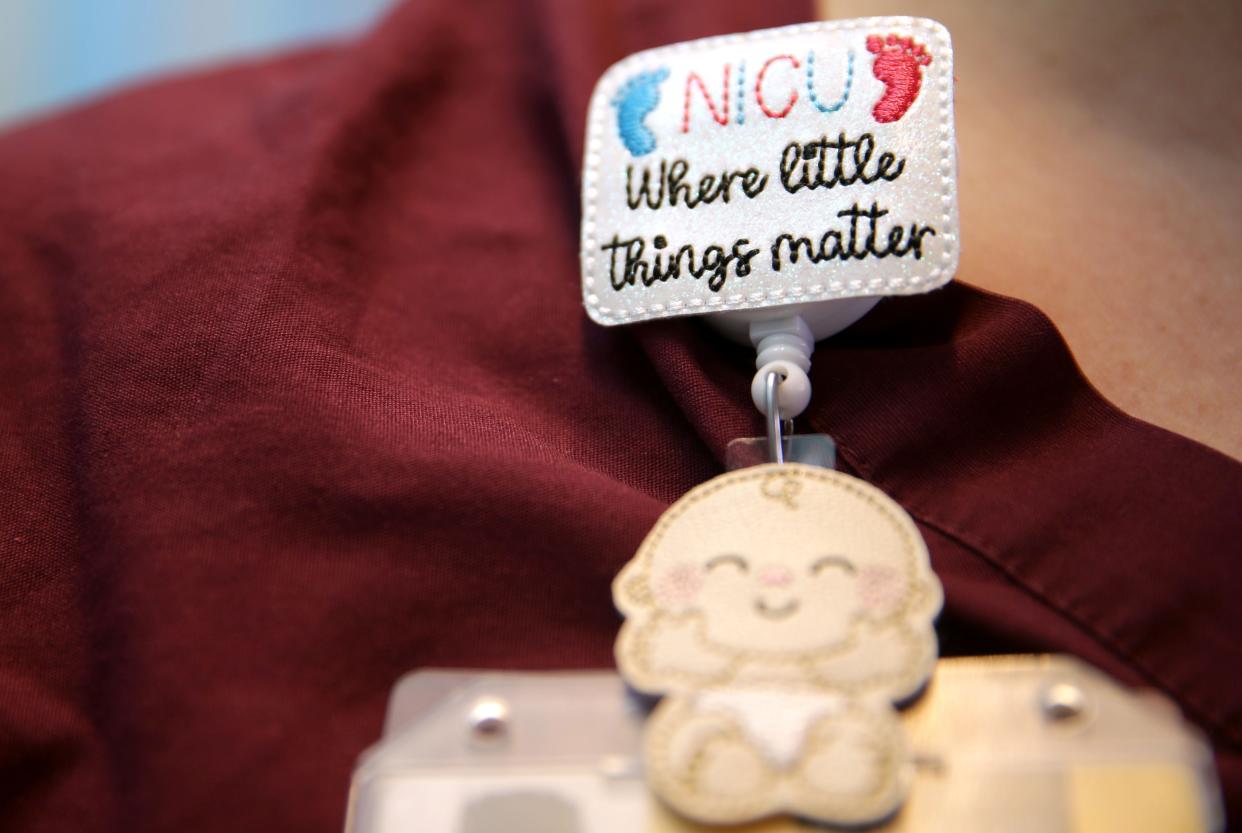
Bereavement is a reality inside hospitals, a truth many people became intimately familiar with during the COVID pandemic. It never gets easier, never becomes rote, Amundson says, but honoring life can be “beautiful.” And it’s a crucial part of the sacred trust between nurse and patient that you’ll be there — no matter what.
Sometimes an illness allows a family weeks, maybe even months, to think about how to say goodbye. Maybe they can even be involved in exactly when care will stop, letting extended family members get to the bedside or allowing multiple agencies across the hospital to get involved in a ceremony and in the mementos they can offer — photos, handprints, the same items parents take home when the story ends differently.
“We want to give our families every opportunity to be as involved as they want to be because you only get to do this one time,” Amundson says. “There's only going to be so many more minutes that this baby is going to be kept artificially alive before we turn off all of our monitors.”
But other times, a patient begins to decline rapidly, and choices have to be made much faster. In nurse speak, those patients are “declaring themselves.”
At her little guy’s bedside, Amundson knows they don’t have much time — both for the parents to wrap their heads around what's happening or for the little guy himself. His little lungs can’t take much more, the ventilator now feeling less like a rhythm and more like a countdown: In… And out… In… And out… In… And out.
What has become clear to Amundson — even across language barriers and cultural gulfs — is the little guy’s parents’ deep faith. As a practicing Catholic, her own spirituality is “a big factor in the way that I live and the way that I nurse and the way that I feel like I have those connections.”
Amundson understands how faith can be the last vestige of hope — and the first hint of healing. It’s always a pillar during her hardest cases.
And that same faith had recently become a titanium backbone as she faced heartbreak outside the hospital’s walls.
‘I felt so much empathy’: Outside the hospital, a nurse sits in her own sadness
Amundson and her husband found each other later in life; she at 37 and he at 41.
They both wanted a family, and both understood the cruel reality that fertility declines as a woman ages — no matter how healthy she stays.
They started trying to conceive before their winter wedding and went through the stages so familiar to those who’ve had any trouble: the chirping apps and colored markers and labeled calendars of ovulation tracking; the battery of invasive tests; the pain and heartbreak of another month without an answer. Another month without a smiley face on that pregnancy test.
She’d long known what it was to spend time in sadness with her patients. But now being told that her dream of motherhood might never happen — that the life she had envisioned for herself since afternoons in her mother’s preschool classroom might not come to be — she’d learned to marinate in her own heartache, too. And to find salve enough to push forward through another shift and another and another.
After months of checkups, Amundson was given an 11% chance of getting pregnant naturally. Their best chance, she was told, was in vitro fertilization, better known as IVF, a surgical procedure where doctors remove her eggs, fertilize them and then implant them again.
“We went through the beginning of that long process and were on the schedule for a retrieval and were getting ready to figure out when we were going to start meds, what’s the schedule going to be and all of that,” Amundson says.
By the time her little guy came onto the unit, the Amundsons had a month or so before all that would start. Give yourself a break in the meantime, her doctor said. No more tests. Put away the apps and the calendars. Just breathe and prepare your body for new life. In.... And out.
“Where I was in my journey of just wanting to conceive so badly, I felt so much empathy for these parents because I know that what they wanted was just a healthy baby,” she says.
“Then to see that crushing reality of them learning that was not how this was going to turn out. It did, it just broke my heart, and I just wanted to do anything physically possible to try to comfort them as much as I could.”
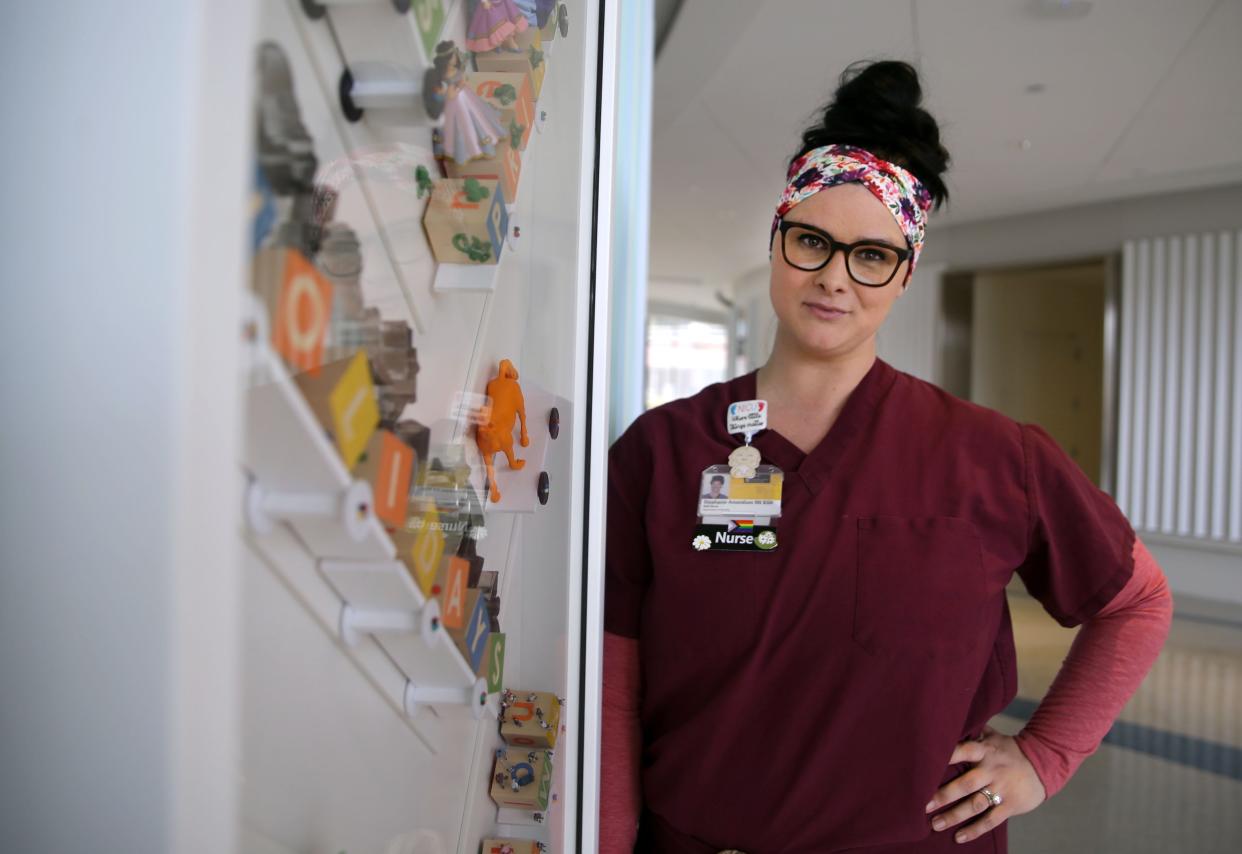
Healing is both returning to health and alleviating suffering
Amundson’s phone rings early Wednesday, the night she decided to pick up an extra shift. Dayside didn’t think her little guy was going to make it through the evening. Can you come in early? a nurse asks.
Of course, she says.
By the time she arrives, her little guy is declaring himself. Time is not on their side. So she picks up conversations with his parents: Will you want to be there when he is taken off the machines? Will you want to hold him afterward?
They don’t give an answer, but they do want him baptized. No problem, Amundson says. She pages the chaplain on call and pulls down one of the baptismal kits the unit keeps in the bereavement closet, laying out everything a person of faith would need for such a ceremony.
Her little guy’s parents ask her to stay for the rite, which is always an honor, she says. In his room, the ventilator plays noisy background to the prayers and psalms. In… And out… In… And out… In… And out.
Afterward Amundson asks again: Will you want to be there when he is taken off the machines? Will you want to hold him?
The parents still aren’t sure. But they’d brought a special outfit and blanket from home, things her little guy’s mother wanted him to have through whatever happens next. Amundson walks to their mother-baby room — where their entire world seemed different just 48 hours ago — and collects the items they’d hoped their son would wear when he left the hospital.
It’s clear now her little guy isn’t going home. And his life isn’t going to be the one his parents envisioned. Will you want to be there when he is taken off of the machines? she asks. Will you want to hold him?
Finally, they reply: They can't do it.
We know that he's already gone, Amundson remembers her little guy’s dad saying. His body is here, but his soul has already left.
They don’t want any of the mementos, no photos or handprints. They just want to go back to their room, where family is waiting, and grieve together.
Amundson gently clasps the mother’s hand and says she’ll stay with him, she’ll hold him as they disconnect the machines.
“She looked down and started crying,” Amundson says. “She was like, ‘You’ll be here? You’ll hold him?’”
I will be here with him the whole time, she reassures his parents.
This is not the first time Amundson has been the last warm embrace a baby felt before crossing through the final veil, but each time feels hallowed. Her job is to heal, she reminds herself, a word that equally means to restore to health or to alleviate from suffering.
“I really felt like that was my job, to get him the rest of the way,” she says. To be “a bridge to the end.”
The team members helping her little guy to the end were all veterans, well-versed in the way the mood changes when care transitions to comfort, from physical to spiritual.
Whatever coldness exists in a hospital fades away; nothing methodical or medical. And what’s left is a group of people who once carried the yoke of fighting, fighting, fighting, but who now shoulder the weight of a final peace. That pulsing deep in your bones is no less intense, Amundson says, but it's markedly different, too. Like stepping into a new skin on top of shifted ground.
They bring the couch back into the room and load it up with pillows, piling them like a fort around Amundson. They close the curtain. They play soft lullaby music.
They keep her little guy connected to the ventilator until he is wrapped in his blanket, wearing his special outfit, and situated just so in Amundson’s arms. She wants his last sensation to be touch.
As they take the breathing tube out, she strokes his cheek, rubbing any remnants of the machine from his face. She thinks about what she would want for her child if this was their family’s story. So she bundles him against her chest’s strong heartbeat and pats his back.
Most babies are born with nearly mature hearing, so she whispers in his ear: It's OK. You can let go. I know this is so hard. You are such a fighter. But it's OK to be at peace now.
We love you.
His chest battles with breath. In… And out…… In…… And out.........
…………In…………And out.
And out.
She prays silently that above all, her little guy knew he was loved.
Then she leans over and kisses his forehead.
Finding ‘beautiful things’ in difficult stories
Amundson had been there when her little guy was admitted, a teeny, tiny football in the center of a medical storm so large they moved furniture to make room for machines.
After his last breath, she gives him his final bath before re-dressing him in the special outfit his mother picked out and wrapping him in the blanket she’d brought from home. “So he had something that was his,” she says.
And then she tucks him in her arms just so and carries her little guy to the morgue.
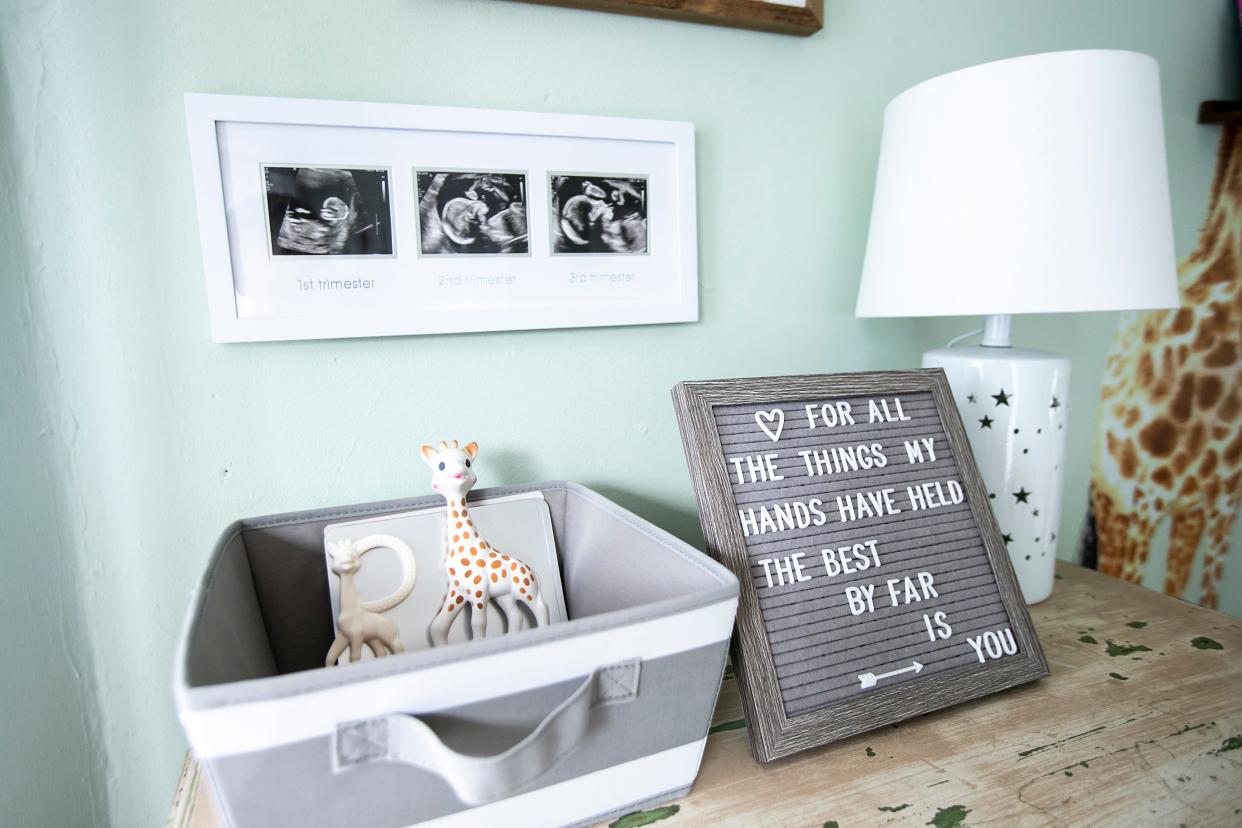
Over the course of her little guy’s three days of life, Amundson was constantly reminded that when medicine isn’t working and scientific answers elude, all that’s left is to care and care deeply.
To sit with someone in silence. To hold their hand. To say, I’ll be here the whole time.
Certain cases stick with nurses. Patients and situations where the details are clear, years and many, many happier endings later. Amundson can still see her little guy’s parents, glassy-eyed and shellshocked. Can still put herself right back in that baptism. And sitting amidst nearly all the pillows the unit could muster.
“I'm still in contact with some of the families that I bereaved their children over a decade ago,” she says. She’ll get messages from them on anniversaries of their babies’ births or their deaths: You’ll never know how much it meant that you were there for us.
What we do in the worst of times often reveals humanity’s most basic truth: Humans weren’t meant to be alone. We were meant to love and be loved in return — no matter how short our time.
“This particular situation, going through all of these days, really cemented for me that I am never going to shy away from taking the most critical patient, taking the sickest patient, taking the biggest challenge,” Amundson says.
“Even if the ending is not what you wanted, or even if the ending to your story isn't what you thought it was going to be at the beginning, there's still beautiful things you can find in it.”
So she comes back. When it’s difficult, when it’s frustrating, when faith is shaken. Nearly two decades as a nurse has taught Amundson to come back and do it again the next day and the day after that and the day after that.
We’d been talking for nearly two hours when the blanket she had bundled against her chest unexpectedly stirs.
A few weeks after she’d bathed and wrapped one little guy, a second heartbeat bloomed inside Amundson. Like her doctor advised, she’d put away all the chirping apps and colored markers and labeled calendars. She’d breathed — In… And out — to prepare her body for new life.
And despite the unlikelihood, Amundson and her husband had conceived naturally.
Soft lullaby music plays in the background as she rocks and pats her little guy, Sebastian.
“What’s up, little man?” Amundson says, adding in a whisper in his ear: It’s OK. Just a second. Almost done.
I love you.
Then — his deep sleep giving way to hunger as we finished up — she leans over and kisses his forehead.
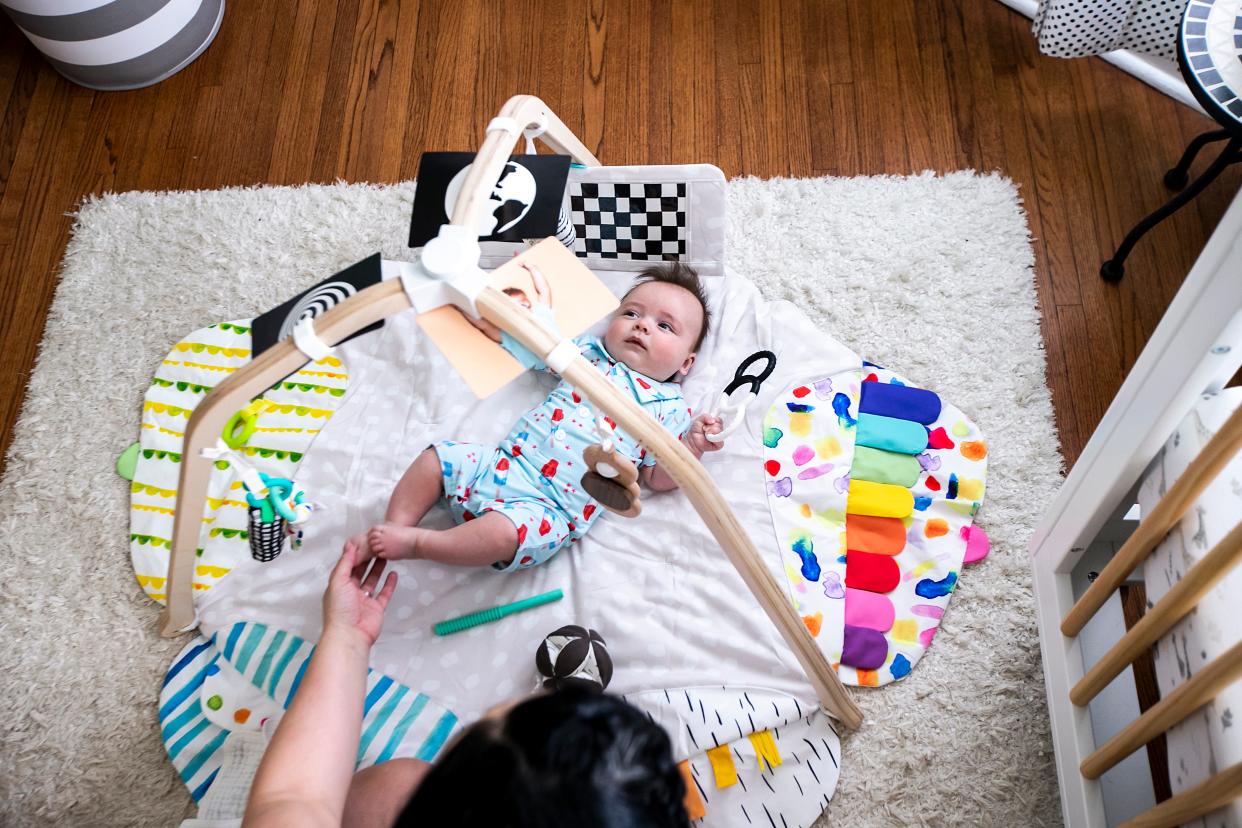
Courtney Crowder, the Register's Iowa Columnist, traverses the state's 99 counties telling Iowans' stories. Reach her at ccrowder@dmreg.com or 515-284-8360.
This article originally appeared on Des Moines Register: Iowa nurse holds dying baby, fulfilling a caregiver's sacred trust
